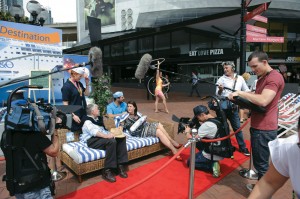Inside the celebrity boardroom bitch-fest
With the grand finale airing tonight, Nine’s end-of-year ratings push has been led five nights a week by the FremantleMedia-produced Celebrity Apprentice. Georgina Pearson visits the set during the show’s six-week Sydney shoot to find out how the series came together.
Celebrity Apprentice is an interesting concept; one that perhaps, on paper, could be deemed a marketing nightmare. For how can you take B-grade Australian celebs and replicate the hugely successful multi-billion dollar Donald Trump-helmed hit?
For the unfamiliar, the premise is fairly simple: 12 celebrity contestants, each vying for a final prize of $100,000 for their chosen charity. Entrepreneur and founder of wealth management company Yellow Brick Road, Mark Bouris, presides as the ultimate boss. Guided by ACP Magazines’ Deborah Thomas and Bouris’ long time right-hand man Brad Seymour, Bouris puts the contestants through their paces with a series of team challenges before gradually eliminating them in a boardroom showdown.



I WOULD LIKE TO COMMENT ON SHANE AND JACINTA LOSING THE GAME …??? THEY GOT SACKED BECAUSE THEY FORGOT A PHONE NUMBER …I AGREE A MISTAKE ……BUT AS THE SHOW WAS ON CHANNEL NINE HAD ADS ON ..AND THE ONE I TOOK NOTICE OF WAS THE YELLOW BRICK ROAD AD AND AT THE END THE STILL SHOT ” HAD NO PHONE NUMBER” I THINK MR BOURIS WAS WRONG ….. LOVED THE SHOW WELL DONE TO ALL CONCERNED ….